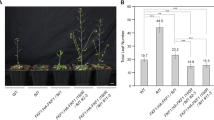Abstract
Previously we showed that the CG9890 protein, which has zinc finger domains, interacts with ENY2-containing complexes and is localized mainly on the promoters of active genes. The CG9890 protein is involved in the regulation of the expression of some of the genes on the promoters of which it is located, and among these genes there are genes for the ecdysone cascade. In this work, the role of the CG9890 protein in the regulation of ecdysone-dependent inducible transcription was studied. For this, 12 ecdysone-dependent genes on the promoters of which the CG9890 protein is localized were identified. Their activation was studied after the addition of 20-hydroxyecdysone to cells, both in normal conditions and after RNA interference of CG9890. The expression of ecdysone-dependent genes is significantly increased in response to the treatment of cells with ecdysone, in contrast to the control genes. Moreover, in the cell line after RNA interference CG9890, the transcription of 8 out of 12 genes was significantly higher than in the control line. Thus, the CG9890 protein is involved in the regulation of transcription of ecdysone-dependent genes, and, in most cases, acts as a repressor.



Similar content being viewed by others
REFERENCES
Vorobyeva N.E., Mazina M.U., Golovnin A.K., Kopytova D.V., Gurskiy D.Y., Nabirochkina E.N., Georgieva S.G., Georgiev P.G., Krasnov A.N. 2013. Insulator protein Su(Hw) recruits SAGA and Brahma complexes and constitutes part of origin recognition complex-binding sites in the Drosophila genome. Nucleic Acids Res. 41, 5717‒5730.
Mazina M.Yu., Vorobyeva N.E., Krasnov A.N. 2013. The ability of the Su(Hw) protein to create a platform for ORC binding does not depend on the type of surrounding chromatin. Cell Tissue Biol. 55, 362–368.
Vorobyeva N.E., Nikolenko J.V., Krasnov A.N., Kuzmina J.L., Panov V.V., Nabirochkina E.N., Georgieva S.G., Shidlovskii Y.V. 2011. SAYP interacts with DHR3 nuclear receptor and participates in ecdysone-dependent transcription regulation. Cell Cycle. 10, 1821‒1827.
Kopytova D.V., Krasnov A.N., Orlova A.V., Gurskiy D.Y., Nabirochkina E.N., Georgieva S.G., Shidlovskii Y.V. 2010. ENY2: couple, triple…more? Cell Cycle. 9, 479‒481.
Kurshakova M., Maksimenko O., Golovnin A., Pulina M., Georgieva S., Georgiev P., Krasnov A. 2007. Evolutionarily conserved E(y)2/Sus1 protein is essential for the barrier activity of Su(Hw)-dependent insulators in Drosophila. Mol. Cell. 27, 332‒338.
Krasnov A.N., Kurshakova M.M., Ramensky V.E., Mardanov P.V., Nabirochkina E.N., Georgieva S.G. 2005. A retrocopy of a gene can functionally displace the source gene in evolution. Nucleic Acids Res. 33, 6654‒6661.
Kopytova D., Popova V., Kurshakova M., Shidlovskii Y., Nabirochkina E., Brechalov A., Georgiev G., Georgieva S. 2016. ORC interacts with THSC/TREX-2 and its subunits promote Nxf1 association with mRNP and mRNA export in Drosophila. Nucleic Acids Res. 44, 4920‒4933.
Eaton M.L., Prinz J.A., MacAlpine H.K., Tretyakov G., Kharchenko P.V., MacAlpine D.M. 2011. Chromatin signatures of the Drosophila replication program. Genome Res. 21, 164‒174.
Masai H., Matsumoto S., You Z., Yoshizawa-Sugata N., Oda M. 2010. Eukaryotic chromosome DNA replication: where, when, and how? Annu. Rev. Biochem. 79, 89‒130.
MacAlpine H.K., Gordan R., Powell S.K., Hartemink A.J., MacAlpine D.M. 2010. Drosophila ORC localizes to open chromatin and marks sites of cohesin complex loading. Genome Res. 20, 201‒211.
Fursova N.A., Nikolenko Yu.V., Soshnikova N.V., Mazina M.Yu., Vorobyeva N.E., Krasnov A.N. 2018. Protein CG9890 with zinc finger domains is a new component of Drosophila ENY2-containing complexes. Acta Nat. 10 (4), 110‒114.
Fursova N.A., Mazina M.Yu., Nikolenko Yu.V., Vorobьeva N.E., Krasnov A.N. 2020. Drosophila CG9890 protein containing zinc finger domains colocalizes with chromatin modification and remodeling complexes on gene promoters and is involved in transcription regulation. Acta Nat. 12 (4), 114‒119.
Clemens J.C., Worby C.A., Simonson-Leff N., Muda M., Maehama T., Hemmings B.A., Dixon J.E. 2000. Use of double-stranded RNA interference in Drosophila cell lines to dissect signal transduction pathways. Proc. Natl. Acad. Sci. U. S. A. 97, 6499‒6503.
Mazina M.Y., Nikolenko J.V., Fursova N.A., Nedil’ko P.N., Krasnov A.N., Vorobyeva N.E. 2015. Early-late genes of the ecdysone cascade as models for transcriptional studies. Cell Cycle. 14, 3593‒3601.
Razin S.V., Borunova V.V., Maksimenko O.G., Kantidze O.L. 2012. Cys2His2 zinc finger protein family: classification, functions, and major members. Biochemistry (Moscow). 77, 217–226.
Cheng C., Alexander R., Min R., Leng J., Yip K.Y., Rozowsky J., Yan K.K., Dong X., Djebali S., Ruan Y., Davis C.A., Carninci P., Lassman T., Gingeras T.R., Guigo R., Birney E., Weng Z., Snyder M., Gerstein M. 2012. Understanding transcriptional regulation by integrative analysis of transcription factor binding data. Genome Res. 22, 1658‒1667.
Jiang N., Emberly E., Cuvier O., Hart C.M. 2009. Genome-wide mapping of boundary element-associated factor (BEAF) binding sites in Drosophila melanogaster links BEAF to transcription. Mol. Cell. Biol. 29, 3556‒3568.
Gilchrist D.A., Nechaev S., Lee C., Ghosh S.K., Collins J.B., Li L., Gilmour D.S., Adelman K. 2008. NELF-mediated stalling of Pol II can enhance gene expression by blocking promoter-proximal nucleosome assembly. Genes Dev. 22, 1921‒1933.
Mazina M.Y., Kovalenko E.V., Vorobyeva N.E. 2021. The negative elongation factor NELF promotes induced transcriptional response of Drosophila ecdysone-dependent genes. Sci. Rep. 11, 172.
Brookes E., de Santiago I., Hebenstreit D., Morris K.J., Carroll T., Xie S.Q., Stock J.K., Heidemann M., Eick D., Nozaki N., Kimura H., Ragoussis J., Teichmann S.A., Pombo A. 2012. Polycomb associates genome-wide with a specific RNA polymerase II variant, and regulates metabolic genes in ESCs. Cell Stem Cell. 10, 157‒170.
ACKNOWLEDGMENTS
The work was performed using the equipment of the Central Collective Use Center of the IBG RAS.
Funding
The study was financed by the Russian Science Foundation (project no. 20-14-00269).
Author information
Authors and Affiliations
Corresponding author
Ethics declarations
The authors declare they have no conflicts of interest. In this work, humans and animals were not used as research objects.
Rights and permissions
About this article
Cite this article
Nikolenko, J.V., Fursova, N.A., Mazina, M.Y. et al. The Drosophila CG9890 Protein is Involved in the Regulation of Ecdysone-Dependent Transcription. Mol Biol 56, 517–522 (2022). https://doi.org/10.1134/S0026893322040082
Received:
Revised:
Accepted:
Published:
Issue Date:
DOI: https://doi.org/10.1134/S0026893322040082




